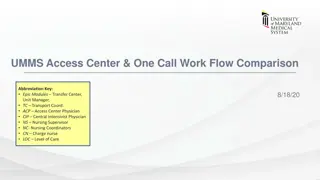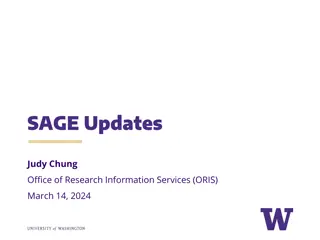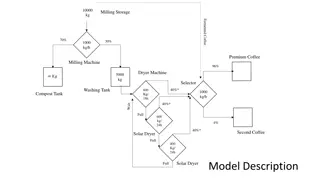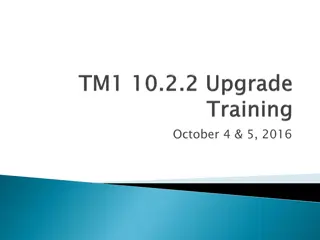Improving Office Workflow for Enhanced Productivity: Strategies by Dr. Monica M. Woodall
Dr. Monica M. Woodall, an experienced family physician, shares insights on diagnosing and treating office workflow issues in a medical practice. From defining key terms like workflow and bottlenecks to identifying symptoms indicating workflow problems, she highlights the importance of streamlining workflows for enhanced provider and patient satisfaction, reduced burnout, and improved overall office efficiency.
Download Presentation

Please find below an Image/Link to download the presentation.
The content on the website is provided AS IS for your information and personal use only. It may not be sold, licensed, or shared on other websites without obtaining consent from the author.If you encounter any issues during the download, it is possible that the publisher has removed the file from their server.
You are allowed to download the files provided on this website for personal or commercial use, subject to the condition that they are used lawfully. All files are the property of their respective owners.
The content on the website is provided AS IS for your information and personal use only. It may not be sold, licensed, or shared on other websites without obtaining consent from the author.
E N D
Presentation Transcript
Diagnosing and Treating Office Workflow Issues Monica M. Woodall, DO, FACOFP Family Practice Durant, Oklahoma
Financial Disclosures I have no relevant financial relationships or affiliations with commercial interests to disclose.
A little about me. Graduated from OSU-COM in 2009 Graduated from Durant Family Med Residency in 2012 Private practice from 2012-2016 (out/inpatient, nursing homes, ER) Job change in 2016 (outpatient, nursing homes, urgent care and occupational medicine) Talk to my friends that are docs/providers None of this was taught in residency, but I paid close attention as a medical student and resident rotating through clinics and my own clinics.
Objectives Definitions Discuss why this is important How to diagnose workflow issues Easy treatments for workflow issues What I have done/currently do in my practice
Definitions Workflow: Steps that accomplish a task, how the work actually gets done, this definition doesn t include protocols Workflow Mapping: Can be a list or picture, order of events that occur to a goal endpoint, makes the invisible now visible Bottlenecks: An event that occurs that disrupts flow, decreases output, two types (episodic, ongoing) Waste: Not useful event/circumstance that has no benefit Unnecessary Motion: Can be physical or virtual, back tracking, can be for patients and staff Cycle time: The time it takes patient from entry to exit, can reveal bottlenecks
Symptoms? Staying late to chart? Staff overtime? Unhappy patients? Doing today s work tomorrow? Behind on tasks? Burnt out? Poor office morale?
Why is this important? Improving workflow means Provider and staff satisfaction increase because of less frustration Patient satisfaction improves because needs are met more efficiently More time to perform other tasks see more patients Decrease burnout for staff and provider Improve office morale Reducing opportunity for errors More organized
Burnout! A study showed that less than 1/3 of FM and IM docs would choose the same specialty if they had to do it all over Only 27% of time spent with patient face to face, but 50% spent with EHR It would take 21 hours per day to take care of a panel of 2500 patients
Albert Einstein said that the definition of insanity is doing the same thing and expecting change.
Possible Challenges Work under a large company Work under a private employer People are often resistant to change Patients are set in their ways Retrain staff
Clinic Flow This lecture will have to be individualized for your office No office is the same (outpatient, inpatient, nursing homes) No staff is the same, may need to be cross-trained Everyone has different needs Depends on what you have to offer (specialty, labs/rad on-site, procedures) Some bottlenecks you cannot prevent: patient calls, refills, physician to physician calls, referrals, lab/rad review
Possible Flow Issues Bottlenecks Not prepared Redundancy Unorganized Patients late or don t show High volume of phone calls Insurance not good Lack of communication Unsure of staff duties High volume of refills Labs and test review overwhelming Charting
Diagnosing Workflow Issues: 3 Ways 1. Make a list of interruptions during your day 2. Use a Flow Map 3. Use Cycle Times Can be done by . You Volunteer patient Hired
Diagnosing Workflow Issues: Flow Maps List of actual steps in order to complete a task Some steps may be simple, but with this tool can explain complexity
Example of Flow Map Prior to patient visit
Prior to patient visit with provider Summary Call for appt Prepare for appt Drive and find clinic Park Find check-in Paperwork Copay Verify Insurance Nurse triage Possible Issues Difficult time with phones Didn t bring med list or meds Cannot find clinic Cannot find place to park Cannot find check in Unexpected paperwork Do not have copay Didn t bring insurance cards Not ready for triage Long walk to room Other people checking in at same time
Flow Map Benefits Can eliminate steps not needed Look at value of steps from patient perspective Fewer handoffs Correct errors immediately Question movement of things or people in a process Standardize the process so there is no guess work Remember good flow is a team effort Patient needs to be the focus Use patient surveys as well
Cycle Times: What to measure? Wait to check in Time to complete check in Wait in waiting room Time to move to exam room Wait time for provider Time with provider Time to move to check out Wait time at check out Time checking out
Where could you have issues? Issues and possible solutions
Key Areas to Evaluate Front Office Back Office Physician Office Other
Front Office Common Issues Waiting room check-in Phone lines Messages Paperwork Appointment confirmation Late patients Scheduling appointments Insurance verification Check-out
Front Office: Check-In Is the area clearly marked? Can front office staff see patients that walk in to office? Do you have a designated area for sick patients?
Front Office: Phones Entry point to the clinic Keep number of lines to 2 or less per staff answering Keep phone tree simple Forward voicemails or check them if staff is out Educate patients on how to use tree Encourage usage of patient portal This is #1 complaint in my office
Front Office: Messages 30-35% of phone messages are repeat calls Messages need to be detailed Forwarded to the appropriate person Make clear designations of who takes care of what Encourage patient to use patient portal One study showed having one person to answer the phone helps with flow and increases patient satisfaction (failed in my clinic) I recommend you have a protocol in place for unable to reach patients (EX: Send a letter after 3 VM s/attempts made over 2-3 days)
Front Office: Messages Our office tells patients, If you don t hear back from one of us, we sent in script/did referral/faxed paperwork and this has helped repeat calls at our office We do not use the mentality of no news is good news with results however
Front Office: Paper Work New patient history and forms completed prior to appointment (I also use this to screen patients) Designate ahead of time which patients have paperwork to complete Encourage established patients to come early for other routine paperwork (pre-visit forms) One study actually got rid of the pre-history paperwork and just has staff put in with patient One study showed that pre-appointment questions the patient completed provided better focused exams, more accurate charting, patient s felt more satisfied and involved in their care
Front Office: Appointment Confirmation This has been show to reduce no-shows by 30% Call 2-3 days ahead of time (not 1), so you will have time to fill spot if they need to reschedule Do with real staff or automated (my clinic does both) Physician to discuss no shows with patient (It usually stops after I do this)
Front Office: Late Patients Encourage patients to come early Have a protocol in place Reschedule if unable to accommodate Physician to discuss with patients
Front Office: Appointment Scheduling Train the front office to ask questions regarding needs As the staff gets to know the patients they will learn to not put two talkers together Train to not put certain appointments back to back Train staff to listen to warning signs (chest pain, shortness of breath, neurological weakness)
Front Office: Appointment Scheduling Reduce scheduling restrictions like specific appt types on specific days (EX: physicals on Thursday afternoons) Do not distinguish between urgent and routine appt Only do two types (long and short) Provider must provide 90 days notice if they will be absent because calling to reschedule patients is time consuming and irritates patients
Front Office: Appointment Types 1. Fixed: Set specific appointments, traditional way, 10,15,20,30 minute blocks 2. Wave: Schedule all patients for a given time (EX: Schedule 4 patients per hour, see in order of arrival, great option for late patients) 3. Modified Wave: Schedule all patients for 2 time blocks within the hour, the benefit is less wait time 4. Open Access: Any available appt today, downfall is patient may not be available 5. Modified Open Access (This is what my clinic does)
Front Office: Appointment Type Most successful Open Access Do today s work today Benefit: Patient satisfaction, practice is efficient, provide more timely care Will have to be customized to your needs Also called advanced access or same day scheduling
Ways to make open access successful 1. Balance Supply and Demand: If demand is greater than supply this may not work, perhaps you shouldn t take any more new patients 2. Recalibrate the system to reduce the backlog: This will take time to decrease and you may need to work late for a few weeks to keep up, and will need to stop scheduling future appointments 3. Reduce Appointment Types: Long and short appt only 4. Have a plan for increased demand: (EX: flu season, provider out, staff shortage), plan to open an afternoon up or Saturday if needed 5. Influence Demand: Put with PCP (makes patients happy), rethink return visits, and make the most of that visit 6. Manage bottlenecks
Reasons Open Scheduling May Fail 1. Lack of leadership 2. Inability to balance supply and demand 3. Lack of physician engagement 4. Lack of team engagement
Front Office: Insurance Verification Can be very time consuming Do the day before
Front Office: Check-out Make sure it is clearly marked Communicate what the patient needs also called post visit orders (paper form, electronic, messenger or escort to the check out) Make it clear to the patient they need to check out One study actually just had patients call for an appointment In my office check out collects delinquent balances because it is private, schedules future appt, schedules lab appt, facilitates medical record release, takes care of other paperwork
Back Office Common Issues Chart Preparation Tests Referrals Messages Medical Records
Back Office: Chart Preparation Empower your staff and train them Designate staff to do specific things (clicking boxes, info input) Refills Preventative medicine needs Update history and med reconciliation I preload templates the morning of appointments for my staff to use, and create a to-do list in the chief complaint The huddle is created by back office will discuss this later
Back Office: Staff empowerment Train staff to follow protocols/standing orders Standing orders are recommended by CDC for immunizations Patients will feel more comfortable talking to them on the phone because they are an extension of you Examples of standing orders: Screening tests, immunizations, labs for chronic diseases, point of care testing, medication refills, referrals Train to do pre-auths, close gaps, complete paperwork, design huddles RN s and LPN s can do much more than MA s Use MA s for data input: PHQ9, AWE, and other forms
Back Office: Staffing Recommendations 1 for each provider that sees less than 15 per day 3 per 2 providers that see 15-19 patients each per day 2 per provider that sees over 20 patients per day You can see 1-2 extra patients per day to compensate pay Study has shown that it increased improvement in disease management and prevention Decreased burn out by 50% in providers and less EHR time by adding staff, also increased patient satisfaction
Back Office: Tests and Referrals One person designated to take care of tests and referrals Protocol in place for set up and retrieval of results and consult notes
Back Office: Messages Use a phone tree to get messages to correct person the first time Encourage patient to use patient portal Have 1 person in charge of answering messages
Physician Common Issues Start time Standard process Do today s work today Batching/Que & multitasking Multiple interruptions Poor interaction with patient Charting
Physician: Start Time Start on time! Once you get behind it is difficult to catch up Get to clinic early Set a schedule of when you perform certain tasks I get to the clinic at 5:45 am to preload charts, review labs and consult notes Some visits will take longer than others Staff has patient ready when I walk in (shoes off for diabetic exam, undressed for WWE, labs done, eye exam done for WCC) Allow any provider to use any room to prevent waiting on their room
Physician: Standardized Process Every provider needs to use the same process to prevent confusion among staff and other providers (Ex: One doctor uses EHR, one uses paper) Use protocols: Vaccines, INR s, point of care labs (EX: Kid with fever gets flu, etc.) Use templates
Physician: Batching/Que & Multitasking Do not save up tasks for the end of the day Complete each task as it presents itself to make flow continuous Document as soon as you can Complete messages and refills between patient encounters Multitasking, in one study, showed a decrease of IQ by 10 points (similar to being up all night or under the influence of THC) Can take up at least 30 seconds to refocus, which can actually decrease productivity by 40%
Physician: Interruptions Make a list for a week of what keeps you from maintaining flow Remember some are inevitable Make sure rooms are stocked, standardized (may have 1 drawer for special needs) Use messaging system so you don t have to leave the room Keep patient education and forms in the room Have room set up ahead of time (PAP, joint injection, etc.) Limit interruptions: cell phone use, notifications turned off, make staff aware, turn off email notifications
Physician: Patient Interaction Sit, make eye contact, touch the patient Ask questions like What s been going on in your life? or What else can I help you with or discuss today? This improves patient satisfaction, reduces later phone calls, and the patient feels like you spent more time with them






















